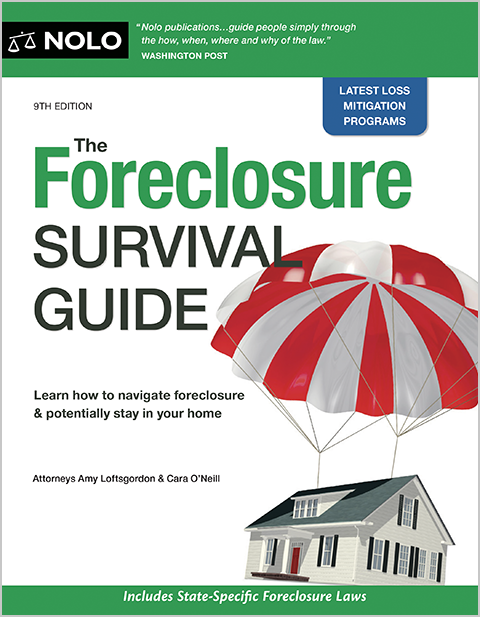Learn how the North Dakota foreclosure process works, your legal rights, and options like loan reinstatement, redemption, or loss mitigation. Stay informed and protect your home.
Before the foreclosure crisis, federal and state laws regulating mortgage servicers and foreclosure procedures were relatively limited and tended to favor foreclosing lenders. However, many federal and state laws now better protect homeowners. Servicers generally must provide borrowers with loss mitigation opportunities, account for each foreclosure step, and carefully comply with foreclosure laws.
Also, most people who take out a loan to buy a residential property in North Dakota sign a promissory note and mortgage. These documents give homeowners some contractual rights in addition to federal and state legal protections.
So, don't get caught off guard if you're a homeowner behind in mortgage payments. Learn about North Dakota foreclosure laws and how the North Dakota foreclosure process works, from missing your first payment to a foreclosure sale.
- Homeowner Rights During the North Dakota Foreclosure Process
- Understanding Preforeclosure in North Dakota
- When Does the North Dakota Foreclosure Process Begin?
- Step-by-Step Guide to the North Dakota Foreclosure Process
- What Are the Options Available for Borrowers During Foreclosure in North Dakota?
- Foreclosure Protections and Military Servicemembers
- North Dakota Foreclosure Laws on Deficiency Judgments
- Consequences of Foreclosure for North Dakota Homeowners
- Where to Get Help and Learn More About North Dakota Foreclosures
Homeowner Rights During the North Dakota Foreclosure Process
In a North Dakota foreclosure, you'll most likely get the right to:
- receive preforeclosure notice
- apply for loss mitigation
- get notice of the foreclosure and the chance to respond in court
- receive special protections if you're in the military
- pay off the loan to prevent a foreclosure sale
- redeem the home after the sale, and
- get any excess money after a foreclosure sale.
Once you understand the North Dakota foreclosure process and your rights, you can make the most of your situation and, hopefully, work out a way to save your home or at least get through the process with as little anxiety as possible.
Understanding Preforeclosure in North Dakota
The period after you fall behind in payments, but before a foreclosure officially starts, is generally called the "preforeclosure" stage. (Sometimes, people refer to the period before a foreclosure sale happens as "preforeclosure," too.)
During the preforeclosure period, the servicer can charge you various fees. Also, in most cases, federal law requires the servicer to let you know how to avoid foreclosure, and most mortgage contracts require the servicer to send you a breach letter.
When Does the North Dakota Foreclosure Process Begin?
Under federal law, the servicer usually can't officially begin a foreclosure until you're more than 120 days past due on payments, subject to a few exceptions. (12 C.F.R. § 1024.41 (2025).) This 120-day period provides most homeowners with ample opportunity to submit a loss mitigation application to the servicer.
Step-by-Step Guide to the North Dakota Foreclosure Process
If you default on your mortgage payments for your home in North Dakota, the foreclosure will be judicial.
Required Preforeclosure Notices for North Dakota Homeowners
In North Dakota, the bank serves, usually through the mail, a notice to the homeowner at least 30 days, but not more than 90 days, before filing a foreclosure lawsuit in court. (N.D. Cent. Code § 32-19-20 (2025).) The notice gives the borrower 30 days to pay the past-due amounts and avoid a foreclosure. (N.D. Cent. Code § 32-19-21 (2025).)
North Dakota Judicial Foreclosure: How It Works
A judicial foreclosure begins when the lender files a lawsuit asking a court for an order allowing a foreclosure sale. You'll learn about the suit when you're served a copy of the complaint and a summons. (N.D. Cent. Code § 32-19-29 (2025).)
If you don't respond to the suit, the lender will ask the court for, and probably receive, a default judgment, which will allow it to hold a foreclosure sale. But if you choose to defend the foreclosure lawsuit, the case will go through the litigation process. The lender might then ask the court to grant summary judgment. A summary judgment motion asks that the court grant judgment in favor of the lender because there's no dispute about the critical aspects of the case. If the court grants summary judgment for the lender or you lose at trial, the judge will enter a judgment and order your home sold at auction.
The officer making the sale must publish a notice of sale in a newspaper once a week for three successive weeks, and, in some cases, mail copies to certain interested parties but not parties with an ownership interest in the property. (N.D. Cent. Code § 28-23-04, § 32-19-08 (2025).)
North Dakota Foreclosure Sales Explained
At the sale, the lender usually makes a credit bid. The lender can bid up to the total amount owed, including fees and costs, or it may bid less. In some states, when the lender is the high bidder at the sale but bids less than the total debt, it can get a deficiency judgment against the borrower. But in many North Dakota foreclosures, a deficiency judgment isn't allowed.
If the lender is the highest bidder, the property becomes what's called "Real Estate Owned" (REO). But if a bidder, say a third party, is the highest bidder and offers more than you owe, and the sale results in excess proceeds (that is, money over and above what's needed to pay off all the liens on your property), you're entitled to that surplus money.
But if the surplus is less than $1,000 and an application to receive the surplus isn't filed with the court within 60 days, the court orders the funds forfeited to the general fund of the county. (N.D. Cent. Code § 32-19-10 (2025).)
What Are the Options Available for Borrowers During Foreclosure in North Dakota?
A few potential ways to stop a foreclosure and keep your home include reinstating the loan, redeeming the property, or filing for bankruptcy. Working out a loss mitigation option, like a loan modification, will also stop a foreclosure.
Or you might be able to work out a short sale or deed in lieu of foreclosure and avoid foreclosure. But you'll have to give up your home with a short sale or deed in lieu of foreclosure transaction.
How to Reinstate Your Mortgage in North Dakota
In North Dakota, the borrower has the right to reinstate the loan within 30 days after service of the preforeclosure notice. (N.D. Cent. Code § 32-19-28 (2025).) Also, many mortgage contracts give the borrower additional time to reinstate. Also, the lender might agree to a later reinstatement.
North Dakota Foreclosure Redemption Period: What You Should Know
One way to stop a foreclosure is by "redeeming" the property. To redeem, you have to pay off the full amount of the loan before the foreclosure sale.
In some states, the borrower can redeem (repurchase) the property within a specific period after the foreclosure. In North Dakota, the borrower generally gets the right to redeem the property within 60 days after the sale except for property that's abandoned or agricultural. (N.D. Cent. Code § 32-19-18 (2025).) Abandoned properties are excluded from the law that provides a redemption period and, if the court determines that the real property is abandoned, it may eliminate the redemption period. (N.D. Cent. Code § 32-19-19 (2025).)
If the property is agricultural, the redemption period is 365 days after the bank files the summons and complaint in the office of the clerk of district court or the time of the first publication of the notice by advertisement, but no earlier than 60 days after the sale. (N.D. Cent. Code § 32-19-18 (2025).)
Using Bankruptcy to Stop Foreclosure in North Dakota
If you're facing a foreclosure, filing for bankruptcy might help. In fact, if a foreclosure sale is scheduled to occur in the next day or so, the best way to stop the sale immediately is by filing for bankruptcy. Once you file for bankruptcy, something called an "automatic stay" goes into effect. The stay functions as an injunction that prohibits the lender from foreclosing on your home or otherwise trying to collect its debt, at least temporarily.
In many cases, filing for Chapter 7 bankruptcy can delay the foreclosure by a matter of months but you'll probably have to give up the property if you're behind in payments. Or, if you want to save your home, filing for Chapter 13 bankruptcy could offer you a way to get caught up on mortgage payments. To find out about the options available to you, speak with a local bankruptcy attorney.
Foreclosure Protections and Military Servicemembers
The federal Servicemembers Civil Relief Act (SCRA) provides legal protections to military personnel at risk of foreclosure.
North Dakota Foreclosure Laws on Deficiency Judgments
In a foreclosure, the borrower's total mortgage debt sometimes exceeds the foreclosure sale price. The difference between the total debt and the sale price is called a "deficiency." For example, say the total debt owed is $400,000, but the home sells for $350,000 at the foreclosure sale. The deficiency is $50,000.
In some states, the lender can seek a personal judgment, a "deficiency judgment," against the debtor to recover the deficiency. Generally, once the lender gets a deficiency judgment, the lender may collect this amount—in our example, $50,000—from the borrower.
Deficiency judgments are prohibited in North Dakota in many cases.
Deficiency Judgment Rules in North Dakota Foreclosures
North Dakota law prohibits deficiency judgments in foreclosures of residential properties of four or fewer units, one of which the owner occupies as a homestead, on up to 40 contiguous acres. (N.D. Cent. Code § 32-19-03 (2025).)
The bank can get a deficiency judgment if the property is agricultural land of more than forty acres. However, the judgment is limited to the difference between the amount of the debt and the fair market value of the land at the time the foreclosure begins. (N.D. Cent. Code § 32-19-03 (2025).)
Consequences of Foreclosure for North Dakota Homeowners
A foreclosure could result in serious consequences, like lower credit scores or tax consequences.
Where to Get Help and Learn More About North Dakota Foreclosures
For more information on federal mortgage servicing laws, as well as foreclosure relief options, go to the Consumer Financial Protection Bureau (CFPB) website. You can also learn more by reading Nolo articles:
- Get tips on what to do—and what not to do—if you're facing a foreclosure.
- Learn about last-minute strategies to stop foreclosure.
- Find out if foreclosures are on the rise.
If you have questions about North Dakota's foreclosure process or want to learn about potential defenses to a foreclosure and possibly fight the foreclosure in court, consider talking to a foreclosure attorney. Talking to a HUD-approved housing counselor about different loss mitigation options is also a good idea.
- Homeowner Rights During the North Dakota Foreclosure Process
- Understanding Preforeclosure in North Dakota
- When Does the North Dakota Foreclosure Process Begin?
- Step-by-Step Guide to the North Dakota Foreclosure Process
- What Are the Options Available for Borrowers During Foreclosure in North Dakota?
- Foreclosure Protections and Military Servicemembers
- North Dakota Foreclosure Laws on Deficiency Judgments
- Consequences of Foreclosure for North Dakota Homeowners
- Where to Get Help and Learn More About North Dakota Foreclosures

